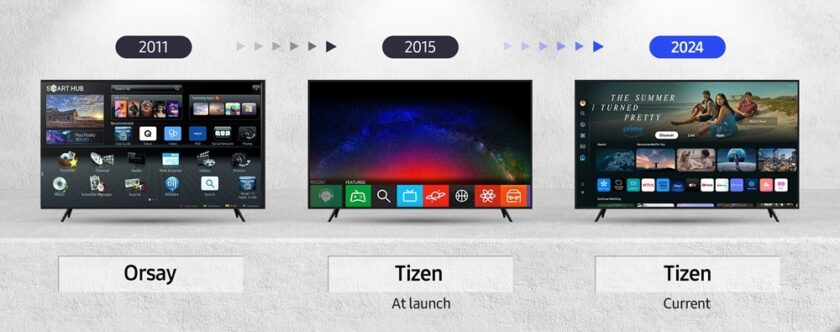The development of Tizen OS is a great success story for Samsung. Since its market launch in 2015, the installed base has grown to 270 million TV and smart signage devices worldwide. Its rapid establishment is largely due to being an open platform. We're looking back on how Tizen OS gained its relevance for digital signage.

Tizen OS: 270m Devices Run on Samsung Platform
At Infocomm 2016, Samsung presented the first digital signage displays with Tizen OS (SSSP 4.0), one year after its launch on the consumer market (German invidis report). Tizen replaced Samsung’s first Smart TV operating system Orsay, which had been introduced in 2011.

As a closed platform, Orsay followed the traditional TV model. It focused on managing signals from any physical input, easily accessible to the user via a graphical interface. This interface was enriched with additional services and functions that were planned, developed, and programmed before the devices were shipped.
Orsay was a closed operating system entirely controlled by Samsung. With all the advantages of a closed system such as easy testing, maintenance, and quality management. But it is precisely this exclusivity that made it difficult for external service and software providers and impossible for the digital signage industry to develop apps.
The introduction of Tizen OS as an open platform was a revolution and a breakthrough for SoC in digital signage. In contrast to the closed platform, the open source code can be changed and distributed more freely. Tizen relies on standardized interfaces and the introduction of standard technologies.
With Tizen OS (SSSP 4.0), external B2B partners, including the digital signage industry, could easily develop new apps using publicly accessible development tools for the first time.
A successful ecosystem requires openness
The success seems to prove companies such as Samsung (Tizen), LG (WebOS) and other display providers (mostly Android) right. Samsung was able to sell 270 million devices with Tizen OS, the majority of which were consumer devices. But a few dozen million smart signage screens are also among them.
In contrast to the closed platform, rolled-out systems can be remotely upgraded with new functions and apps. Tizen has developed into the leading SoC platform in the digital signage industry thanks to Samsung’s high market share. Even if ISVs’ love and passion for Tizen is still limited eight years after its launch, there is no getting around Tizen in the digital signage industry.
Tizen OS also enables Samsung to generate recurring revenue
Tizen OS, which runs on LED displays, smartwatches, consumer TVs, and smart signage, allows Samsung and its partners to generate recurring revenue more easily. Whether through DooH and Retail Media Networks using Samsung Ads in North America or the new smart signage platform VXT, the opportunities are significant.
The development and integration of many new Tizen-based AI functions will soon expand Samsung’s range of capabilities. With a huge installed base but only a few versions, Tizen simplifies development. This is also a reason why Google continues to bring Chrome OS and Android together, because AI development is complex and must be implemented quickly in order to remain competitive.
